Antipyretics for children are prescribed by a pediatrician. But there are emergency situations with fever when the child needs to be given medicine immediately. Then the parents take responsibility and use antipyretic drugs. What is allowed to be given to infants? How can you lower the temperature in older children? What medications are the safest?
The average age of a mother at the birth of her first child is rising, but differences in fertility rates persist
The CIS countries differed significantly in fertility levels at the time of the formation of the Commonwealth, and these differences, despite a certain reduction, still persist. This mainly causes noticeable differences in the age composition of the population, and differences in the age composition of the female population, in turn, influence the number of new births that form the future population.
According to the latest All-Union Population Census of 1989, the average number of children born to women aged 50-54 years who completed the reproductive cycle of their lives varied across the Union republics that subsequently formed the Commonwealth of Independent States, from 1.9 in Ukraine to 6.2 in Tajikistan. In fact, this is the final birth rate of female generations born in 1935-1939. In addition to Ukraine, the generation of women born in these years living in Russia at the time of the census was distinguished by an extremely low birth rate, which does not ensure simple reproduction (2.0). The final birth rate of women born in 1935-1939 was somewhat higher in Belarus (2.3) and Moldova (2.6). In other CIS countries - former union republics, it exceeded 3 children per woman, and in Uzbekistan, Turkmenistan and Tajikistan - 5 children per woman. The highest value - 6.2 children per woman 50-54 years old - was observed in Tajikistan.
Due to a decrease in the birth rate in younger generations, the total birth rate of conventional generations varied to a lesser extent. The value of the total fertility rate varied, according to estimates for 1989, from 1.9 children per woman in Ukraine to 5.1 per woman in Tajikistan. The total fertility rate was below the replacement level not only in Ukraine, but also in Belarus and Russia (2.0 each). In Moldova, Armenia, Azerbaijan and Kazakhstan it was slightly higher, ranging from 2.5 to 2.8 children per woman. In the Central Asian republics it was about 4 children per woman and higher.
In the 1990s, a decline in the birth rate was observed in most CIS countries. In 2000, according to estimates by the CIS Statistics Committee, the value of the total fertility rate varied from 1.1 in Ukraine to 3.5 in Tajikistan. The total fertility of conventional generations has dropped to extremely low levels not only in Ukraine, but also in Russia (1.2), Armenia, Belarus, Moldova (1.3 each) and Kazakhstan (1.8 children per woman). In Kyrgyzstan, Uzbekistan, Tajikistan and Turkmenistan, it also decreased, but remained above the replacement level, exceeding 2.4 children per woman.
Since the mid-2000s, there has been an increase in the birth rate, and according to estimates for 2014, the total fertility rate ranged from 1.3 in Moldova to 3.2 in Kyrgyzstan. Despite the increase, the birth rate remained extremely low in Ukraine (1.5 children per woman), Armenia, Belarus (1.7 each) and Russia (1.8). In Azerbaijan, it approximately corresponded to the level of simple reproduction (2.2); in Kazakhstan and the Central Asian republics it exceeded 2.5 children per woman.
Despite significant differences in the intensity of age-related fertility, its maximum, according to data for 1989 and 2000, in all CIS countries occurred at ages from 20 to 24 years (Fig. 15-18). In 2014, the maximum fertility rates in countries such as Belarus, Kazakhstan, Moldova, Russia, Ukraine and Turkmenistan (according to UN Population Division estimates) were observed in the age group of 25-29 years, or they were close to the fertility rate at the age of 20-29 years. 24 years. Thus, in these countries there has been a shift in the peak birth rate from the age group of 20-24 years to the age group of 25-29 years.
In other countries, the extreme birth rate still falls in the group of women 20-24 years old, although the birth rate has noticeably decreased compared to 1989.
Figures 15-18. Age-specific fertility rates for CIS countries, 1989, 2000 and 2014, live births per 1000 women of the corresponding age
The trend of increasing the age of motherhood and postponing births to later ages, which is typical for developed countries, can be judged by the change in the average age of the mother at the birth of her first child.
According to estimates for 2000-2014, the average age of a mother at the birth of her first child has increased in all CIS countries except Azerbaijan (Figure 19). In 2000, it ranged from 21.1 years in Tajikistan to 24.5 years in Ukraine, and in 2014 – from 22.9 to 27.2 years in the same countries. The greatest increase in the average age of a mother at the birth of her first child was observed in Ukraine (by 2.7 years), Belarus (by 2.4 years) and Armenia (by 2.0). In Kyrgyzstan and Uzbekistan it was no more than six months, and when compared with intermediate values (for 2010), a decrease in the indicator was noted, as in Azerbaijan.
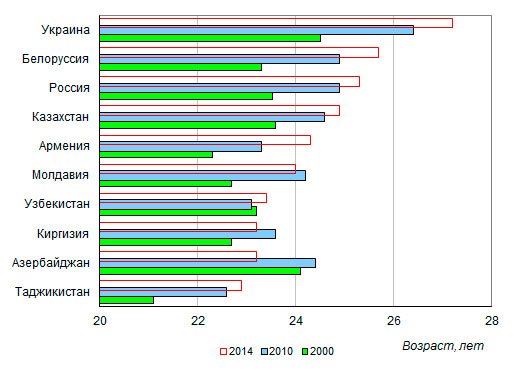
Figure 19. Average age of mother at the birth of her first child in the CIS countries*, 2000, 2010 and 2014, years
In a number of CIS countries, an increase in teenage birth rates (for women under the age of 20) was observed. According to data for 1989, it ranged from 22 live births to mothers under 20 years of age per 1,000 women of the same age in Turkmenistan to 66 in Armenia (Fig. 20). In addition to Armenia, Moldova, Ukraine and Russia also had high birth rates among women under 20 years of age in 1989 (from 53 to 57 live births to mothers under 20 years of age per 1,000 women of the same age).
According to 2014 estimates, the under-20 birth rate ranged from 18 per 1,000 women in Turkmenistan to 53 in Azerbaijan. Compared to 1989, teenage birth rates have decreased in all CIS countries except Azerbaijan and Tajikistan. In these countries it increased by 84% and 21%, respectively. In Azerbaijan, Tajikistan and Kyrgyzstan, teenage birth rate exceeds 40 births per 1,000 women under 20 years of age, in Kazakhstan it is 35, and in other countries it has dropped below 30 births per 1,000 women under 20 years of age, decreasing by 1.5 times or more.
Compared to 2000, a noticeable increase in the teenage birth rate was noted in Azerbaijan and Kyrgyzstan, and a more moderate increase in Kazakhstan, Uzbekistan and Tajikistan. In other CIS countries, on the contrary, it decreased, most significantly in Moldova and Armenia.
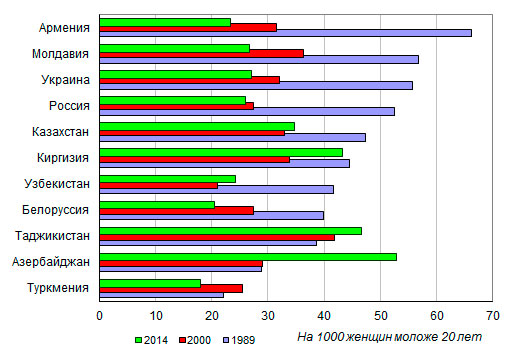
Figure 20. Birth rate for women under 20 years of age in the CIS countries*, 1989, 2000 and 2014, number of live births per 1000 women under 20 years of age
*Turkmenistan – UN assessment of the 2015 revision
Most children born to mothers under 20 years of age are born to adult women 18 years of age or older. According to data for 2014, the birth rate for women aged 19 is at least an order of magnitude higher than for women aged 16 (Fig. 21). However, the birth rate among women 18-19 years old varies significantly. Thus, the birth rate at the age of 19 years ranges from 47 births per 1000 women in Belarus to 129 in Azerbaijan, and at the age of 18 years – from 26 per 1000 women in Tajikistan to 84 in Azerbaijan. The birth rate at the age of 16 is also highest in Azerbaijan (12 live births per 1000 women).
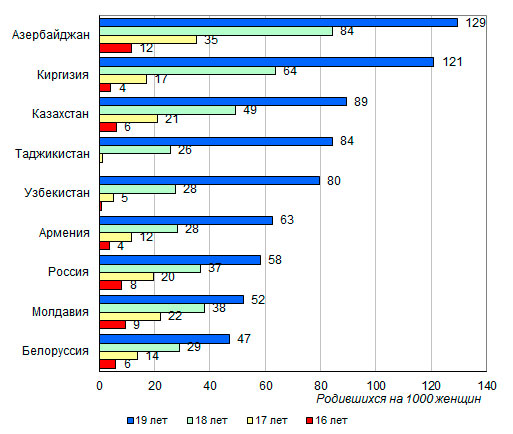
Figure 21. Birth rate for women under 20 years of age, per 1000 women of the corresponding age, 2014
The birth rate at the age of 20-24 years in 2014 ranged from 79 live births per 1000 women in Moldova to 237 in Tajikistan (Fig. 22). Low fertility rates in this age group were observed not only in Moldova, but also in Russia, Belarus and Ukraine (90-92). In Kyrgyzstan and Uzbekistan, on the contrary, they were twice as high (201 and 192 per 1000); in Armenia, Azerbaijan, Kazakhstan and Turkmenistan they ranged from 122 to 169 births per 1000 women.
Compared to 1989, the birth rate at the age of 20-24 years has decreased in all CIS countries. The largest decrease was observed in Moldova (by 127 ppm, or 62%), the smallest in Azerbaijan (by 31 ppm, or 15%).
Compared to 2000, there was an increase in the birth rate at the age of 20-24 years in Kyrgyzstan (by 39 points per mille), Azerbaijan (by 37), Kazakhstan and Tajikistan (by 29), as well as a slight increase in Armenia (by 2 points per mille). In other CIS countries the decline continued, but not as intense as in 1989-2000.
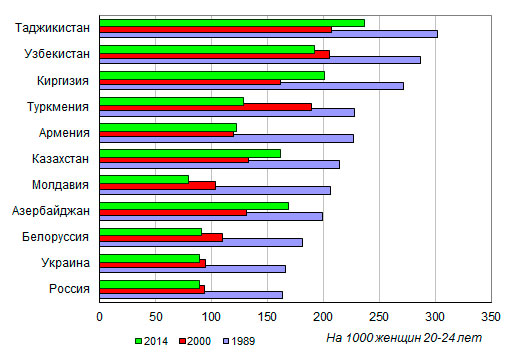
Figure 22. Fertility rate for women 20-24 years old in the CIS countries, 1989, 2000 and 2014, number of live births per 1000 women 20-24 years old
The birth rate at the age of 25-29 years in 2014 ranged from 76 live births per 1000 women in Moldova to 168 in Tajikistan (Fig. 23). In addition to Moldova, women in Ukraine (91 births per 1000 women) and Armenia (102), as well as Russia (110) and Belarus (114) had low birth rates at the age of 25-29 years.
Compared to 1989, the birth rate among women 25-29 years old has decreased in all CIS countries, except for Russia, Belarus and Kazakhstan, in which it increased by several points per mille (4-7%). At the same time, in Tajikistan, Turkmenistan and Moldova, the birth rate at the age of 25-29 years decreased by approximately 40%, in Azerbaijan - by 31%, in Armenia - by 24%, in Kyrgyzstan - by 18%.
If during 1989-2000 the birth rate at the age of 25-29 years decreased in all CIS countries, then during 2000-2014 it, on the contrary, increased to one degree or another in all CIS countries, with the exception of Turkmenistan and Tajikistan.
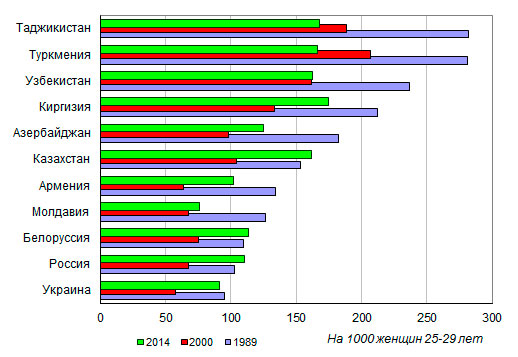
Figure 23. Birth rate for women 25-29 years old in the CIS countries, 1989, 2000 and 2014, number of live births per 1000 women 25-29 years old
Among those born to mothers under the age of 20, firstborns predominate. According to data for 2014, the share of first-born children among those born to mothers under 20 years of age was the lowest in Azerbaijan - 81.3%, another 17.6% were second children, 1.0% were children of the third and higher order (Fig. 24 ). The highest proportion of first-born children among those born to mothers under 20 years of age – more than 93% – was observed in Uzbekistan. It was also more than 90% in Belarus, Tajikistan and Moldova.
Among those born to mothers aged 20-24 years, first-borns also predominate, but their share is lower than among adolescents under 20 years of age: from 52% in Kyrgyzstan to 74% in Belarus. The share of second children among those born to mothers aged 20-24 rises to 40% in Tajikistan and 39% in Azerbaijan. The share of children of higher order also becomes significant.
Among those born to mothers aged 25-29 years, in a number of CIS countries, children of the second order predominate, and in Kyrgyzstan, the majority of children are of the third and higher order. In Belarus, the share of first-born children is the highest (47%), although the share of second-born children is also quite large (42%). The share of children in the third and higher order ranges from 11% in Belarus to 43% in Kyrgyzstan.

Figure 24. Born to mothers under 30 years of age, by maternal age and birth order in the CIS countries*, 2014, %
* Russia, Turkmenistan and Ukraine – no data
The decline in the birth rate occurs as a result of the spread of the practice of its regulation. In the CIS countries, the use of contraception is increasing, but the abortion rate remains relatively high, despite a significant decline. Thus, according to estimates for 2000, the number of abortions at the age of 15-29 years reached 64 per 1000 women in Belarus, 45 in Kazakhstan, 36 in Moldova, and 49 per 1000 women aged 15-34 in Ukraine. In the rest of the CIS countries it was below 20. According to estimates for 2014, the number of abortions decreased and ranged from 12 abortions per 1000 women aged 15-29 in Azerbaijan to 33 in Russia. In Belarus it was 16, in Kyrgyzstan - 17, in Kazakhstan 27 per 1000 women 15-29 years old. In another breakdown by age, the number of abortions per 1000 women aged 15-34 was 6 in Uzbekistan, 9 each in Tajikistan and Ukraine, 20 in Armenia.
According to fragmentary information available, hormonal contraception is most widespread in Belarus (about 19% of women aged 15-49 use it). In Kyrgyzstan, about 8% of women 15-29 years old use it, in Tajikistan - about 7% of women 15-34 years old, in Uzbekistan and Kazakhstan - 3-4% of women 15-49 years old, in Russia and Armenia - just over 1% of women 15-49 years old. Intrauterine devices are most widespread in Uzbekistan (about 40% of women 15-49 years old), half as much in Belarus and noticeably less in Kazakhstan (6%), Armenia and Russia (1% each). Among young women, intrauterine devices are more often used by women in Tajikistan (15% of women 15-34 years old) and Kyrgyzstan (7% of women 15-29 years old).



